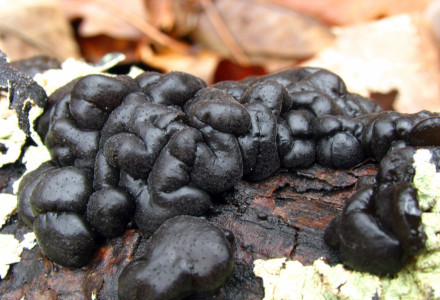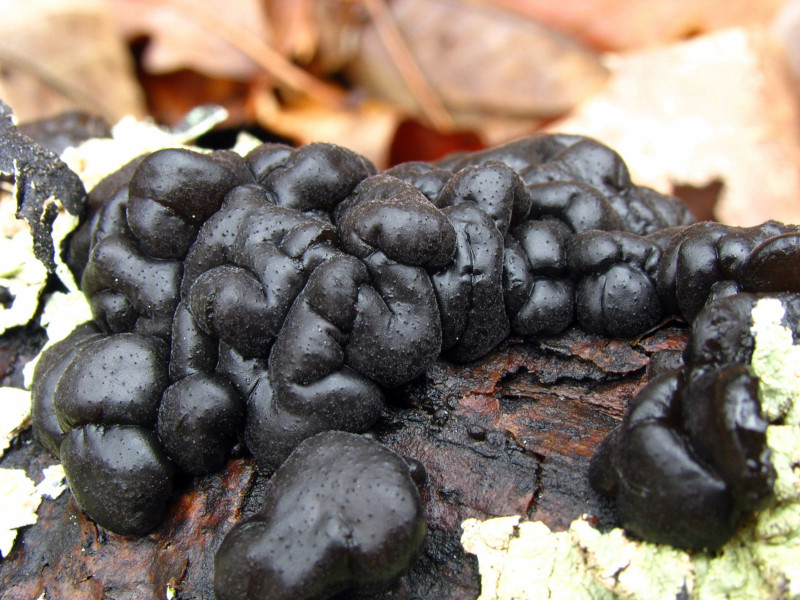Black Witches’ Butter Facts
- The distinctive term of Black Witches’ Butter serves as only the most frequently used name for this amazing fungus. It actually goes by several other alternate names, as well. These include the terms of the black jelly roll, and the warty jelly fungus.
- Its scientific name, however, is that of the Exidia glandulosa. Regardless of which term one uses to refer to it, though, it’s an impressive species. Unfortunately, it’s often confused with another, visually similar species with which its shares its habitat range.
- The first known official recognition of it as a separate and distinct species took place in the year 1789. Regrettably, though, the fungus also served as the center of some controversy in scientific circles. This holds true due to questions about its naming.
- The French botanist Jean Baptiste François Pierre Bulliard made the original identification and naming. In 1822, however, the Swedish botanist and mycologist Elias Magnus Fries placed it in another genus. This combined it with the related species.
- Then, in 1936, experts separated the two again. This occurred at the hands of the German mycologist, Walther Neuhoff. He, however, made yet another mistak, in the naming of the two. Yet another mycologist, Marinus Anton Donk, finally corrected this.
- The impressive and distinctive Black Witches’ Butter seems to have a stable and sufficient population base. This further appears to hold true throughout the entirety of its native range. The IUCN therefore presently has no listing for it on its Red List.
- The fungi nevertheless does face certain threats to its continued existence. Habitat loss certainly poses a danger to it, as the forests it thrives in vanish. Likely, though, the greatest danger it faces comes in the form of the ongoing effects of climate change.
Related Articles
Black Witches’ Butter Physical Description
It must be pointed out that the intriguing Black Witches’ Butter frequently has a highly irregular shape. This therefore makes an accurate description of its physical appearance difficult. Certain basic patterns do appear, however, and it’s those we’ll elaborate on.
Overall, the fruit bodies of this particular fungus attain an average diameter of around 1.2 in (3 cm). This develops on top of an irregularly shaped stalk, usually measuring almost as wide as the cap. These further generally appear in small groupings or clusters.
The body of the fungus also develops a somewhat surprising texture. That’s because this outer covering has a gelatinous or rubbery feel to it. This aspect of the species remains firm, though. This, however, only maintains itself if the mushroom is fresh and young.
When either wet or aged, this changes to a lax nature. Its shape also commonly becomes distorted at this time. The stark black hue of the aptly-named Black Witches’ Butter, though, remains its most noticeable feature. It also frequently has a shiny appearance to it.
- Kingdom: Fungi
- Phylum: Basidiomycota
- Class: Agaricomycetes
- Order: Auriculariales
- Family: Auriculariaceae
- Genus: Exidia
- Species: E. glandulosa
Black Witches’ Butter Distribution, Habitat, and Ecology
For the moment, the precise extent of the range of distribution of the astonishing Black Witches’ Butter remains undetermined. That’s due to the fact that it’s so often confused with another, visually similar, species. The two appear to roughly share the same range.
It can only be said for certain that it inhabits the continent of Europe. It’s frequently spotted in both the United Kingdom and Ireland, among others. Reports further indicate the possibility of its presence, naturally or otherwise, in much of the Northern Hemisphere.
Wherever this marvel of Nature makes an appearance, its habitat preferences continue to be quite clear. That’s because it’s commonly seen in regions of forest. Although it lives among evergreens as well, it typically appears in regions of mainly deciduous trees.
Even within that ecosystem, though, it still has preferences. The intrepid fungus most frequently makes its home on various broadleaf trees. That further most commonly consists of oak. Others, such as beech or hazel, sometimes serve as host to the fungus, though.
Like many of its related species, the Black Witches’ Butter evolved as a wood-rotting variety. When it makes an appearance on a host tree, it usually does so on a dead limb. Once there, it typically produces the distinctive fruit bodies in Autumn and Winter.
Species Sharing Its Range
Check out our other articles on 4 Herbaceous Plants of Virginia, Tufted coquette, Chandipur Beach, Finless Porpoise, Chinese Mantis, Plumed Basilisk, Rose’s Ghost Frog


